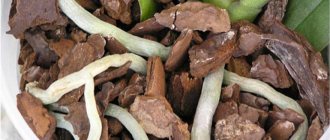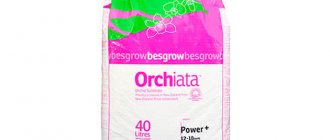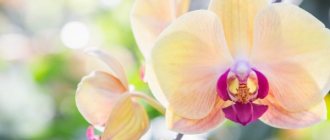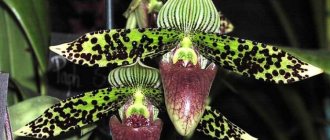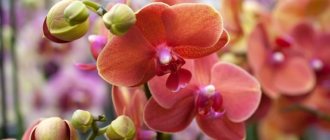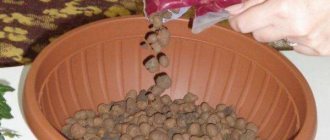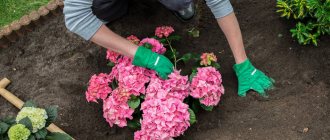Orchids are classified as tropical plants. It is important for them to find the optimal water balance. For flowers, it is recommended to maintain the “dry-wet” regime. The soil is moistened abundantly. The next watering is carried out when it dries well.
Good drainage is important for plants. They do not develop well enough in soil mixtures and often get sick. Flower growers recommend using a complex from the German manufacturer Seramis, created specifically for orchids. What does it consist of? How to grow flowers on it?
What it is?
Attention : Seramis is a ready-made balanced complex intended for caring for indoor plants. The product is clay granules enriched with several types of fertilizers.
Components for Seramis are supplied by Germany . Recently, this substrate has become popular in Russia. In Western Europe, it is actively used when planting potted plants.
Small clay granules are porous and lightweight. They actively absorb excess moisture. The soil does not lose its properties regardless of operating conditions and period.
Unlike other soil mixtures, Seramis provides good air exchange in the pot . With such a substrate, orchids feel comfortable and enjoy healthy growth and abundant flowering.
If after replanting the soil is not completely used, it must be properly stored in a dry, dark place.
We recommend watching a video about Seramis for orchids:
Recommendations
There are some other nuances when using Seramis. Experienced gardeners give several additional recommendations for using soil.
Although eggs, larvae and mold do not survive in this composition , this problem cannot always be avoided when using rainwater. Rainwater contains microdust, which gradually accumulates between soil granules, and in these spaces pathogenic microorganisms feel quite comfortable. Therefore, do not use rainwater when watering orchids.
Seramis should not be considered a nutritional composition. When using it, plants also need to be fed regularly. Any complexes are suitable for flowers grown in General Purpose Ceramis. If “Ceramis for orchids” is used, then it is necessary to fertilize the flowers only with fertilizers from the Seramis line. When transferring a crop to a new fertilizer, you must wait until it is completely starved, and only then start using the new composition.
The next tip concerns the storage of Seramis. All its varieties do not require special conditions for this and can be stored in torn and sealed packaging, preventing the ingress of moisture and air. However, Seramis for Orchids cannot be stored in an opened bag. It is best to completely use the purchased mixture at one time. But if this is not necessary, then the container is also sealed with tape, put into a sealed plastic bag, sealed with tape again and stored in a dark room at a maximum temperature of +22 degrees.
Compound
The Seramis complex is a substitute for natural soil for orchids . The substrate is made from baked clay and tree bark. Contains beneficial microelements NPK:
- Phosphorus.
- Potassium.
- Nitrogen.
Clay granulate particles absorb watering moisture like a sponge and distribute it throughout the pot. Thanks to the safe accumulation of liquid, plants are protected from root rot.
Substrate granules of different sizes . This makes it possible to save the life of even a small shoot with undeveloped roots.
Description of the soil
Of course, to get a high-quality substrate selected in individual proportions, prepare it yourself
Otherwise, pay attention to the following ready-made mixtures:
- “Bio Start Effect” made in Russia. The mixture is made exclusively from natural, organic ingredients. The soil is fine-grained, fraction size 8-13 mm. The substrate does not require disinfection and is completely ready for use. The cost of a 2 liter package is 350 rubles.
- “Gardens of Aurica” for orchid pros. The soil mixture consists of: wood ash, bark, moss, coconut chips. The composition also includes vermicompost, which in such a volume does not benefit the plant, and there is a tiny amount of bark. The volume of the substrate is designed for a pot with a capacity of up to 1.7 liters. For drainage, you can use coconut fiber, which is included in the kit. The cost of the set is 100 rubles.
- "Seramis" - planting mixture developed specifically for orchids. The composition contains coarsely fractionated expanded clay granules, pine bark and additional micronutrients. The substrate provides the necessary air exchange, promotes active growth, and maintains water balance. Price 950 rubles. Soil content in the bag is 2.5 liters.
In order to make the right choice and buy the best soil for your orchid, study the quality criteria of ready-made soil mixtures.
Advantages and disadvantages
Like any ready-made soil mixture, Seramis can have both advantages and disadvantages. Positive qualities of the substrate:
- Maintaining its original structure regardless of time.
- Easy to use when transplanting plants.
- There is no need to replace the soil several times a season.
- Avoiding pot leakage. The substrate can be poured into containers without drainage holes.
- Possibility of reuse in case of death of the plant in the pot. The mixture is washed and “baked” in the oven for half an hour.
- Reducing the risk of fungi and mold.
Seramis can be used for many years in unlimited quantities. Plants are transplanted into prepared soil without clearing the roots from the soil, and they quickly get used to the new place. There were no deficiencies found in this soil mixture.
Seramis is a universal granule for orchids that feed on air (epiphytic plants) . This soil is suitable for planting both Vanda and Phalaenopsis.
Types of orchids and ceramis
Seramis is a universal granular soil for air-feeding orchids. That is, it is suitable for epiphytic plants. Ground species of the flower take root in fertile soils, but if you know the peculiarities of transplantation, they can also be grown in a clay substrate.
This substrate from a German manufacturer is suitable for both Phalaenopsis and Vanda. Indoor flowers can grow on a granular substrate provided that fertile soil is mixed into it. And if desired, it can be used as aquarium soil with the possibility of growing algae.
Features of planting in soil mixture
Replanting an orchid is a responsible task for both beginners and experienced gardeners. In order for the plant to take root and delight with lush flowering, it is important to strictly follow the transplantation rules.
The orchid is transferred to the substrate only after it has bloomed . The peduncle is cut to restore vitality after replanting.
Before performing the work, prepare the following equipment:
- Manicure scissors or garden pruning shears.
- A new orchid pot, larger in size than the previous one.
- Seramis series primer.
- An activated carbon tablet or bactericidal preparations for treating cut sites. This will save the orchid from death.
Plastic, ceramic pots, glass and even metal containers are suitable for filling with Seramis . Metal containers are lined with foil inside to avoid oxidative processes.
And we will talk in more detail about pots for orchids, for example, the Corona type, transparent ones, flowerpots, glass vases, flasks and others, as well as about planting in a block, in other articles.
The flower is removed from the old container with great care so as not to harm the fragile root system. To facilitate this task, the orchid is not watered before planting. It is not necessary to clear the roots from the previous soil. Further actions are carried out sequentially:
- The root system of the flower is examined to identify lesions. If a pest is detected, the plant is immersed in filtered warm water. For the final destruction of parasites, special preparations are used.
- The roots are diagnosed. Rotten and dried ones are cut with scissors or pruning shears. The cut areas are treated with bactericidal compounds or activated carbon.
- Remove yellow and lifeless leaves and soft hollow bulbs. The cut sites are disinfected.
- The orchid roots are dried for eight hours.
- Prepare a container for the plant - disinfect it, lay a drainage layer.
- After 8 hours, the flower is carefully placed in the middle of the pot, filling the voids with Seramis soil mixture. The ratio of soil and rhizomes of the planted orchid should be 2:1. Aerial roots do not fall asleep.
The substrate is placed in a container with a flower so that it does not dangle . The soil is not compacted.
We recommend watching a video about transplanting an orchid into Seramis:
Which soil is better?
What substrate is needed for orchids? The substrate is selected in accordance with the type of flower, the type of nutrition and the characteristics of the root system.
Thus, phalaenopsis, which has photosynthetic roots and needs a transparent pot, requires a simple, loose substrate with high air permeability and moisture capacity.
The following is used as soil for these varieties of orchids:
- Koru;
- Coconut shavings or blocks;
- Or a mixture of perlite;
- Sphagnum;
- Bark and coconut fiber.
The substrate used for dendrobiums is:
- From pure bark;
- Either from the bark;
- And sphagnum.
Miltonias grow well in a mixture of:
- Fine-grained bark;
- Moss;
- Peat;
- Charcoal;
- And perlite.
Cambrias prefer to grow in a substrate whose components slowly decompose and oxidize, so for these orchids mixtures of:
- Peat;
- Moss;
- A small amount of bark;
- Charcoal;
- And expanded clay.
Cattleyas respond well to transplanting into a mixture of:
- Bark;
- And sphagnum;
- With a small amount of charcoal acting as an antiseptic;
- Instead of sphagnum moss, you can choose coconut fiber.
Vanda responds best to growth in clean pine bark, but if the air in the apartment is dry, you can spread moss on top, which is periodically sprayed, thereby maintaining the necessary humidity.
Comparative characteristics
The substrate prepared yourself will be prepared more thoroughly, because you calculate the components based not only on the preferences of the type of orchid, but taking into account the individual characteristics of the place where it will be kept. The composition of the compo substrate is well suited for orchids.
The best substrate is the one you make yourself.
So, if there is a lack of moisture, more sphagnum moss is added to the mixture, for example.
Important! For beginning orchid growers, it is best to choose ready-made soil, balanced and composed in the right proportions, in order to avoid mistakes caused by a lack of practical experience.
Large or small?
For large-sized plants, it is better to choose soil with large and medium fractions, for small and dwarf varieties - a finer-grained substrate.
Growing a flower in a substrate
Orchids planted in the substrate must be provided with proper care so that they recover faster. After replanting, the pot with the plant is left in the same place or moved to the eastern window. Basic rules for flower care in Seramis:
The first watering after transplantation should be carried out after 4-5 days. To moisturize, use clean warm water.- Protect the orchid from direct sunlight.
- Maintain the temperature in the range from plus 20 to 22 degrees.
Watering orchids growing in Seramis is done no more than once every 20 days . For better orientation in the orchid pot, install a humidity indicator. Blue indicates good fluid balance. Red signals the need for watering.
Tip : In order for the flower to quickly take root in a new place, a complex fertilizer of the same series is added to the irrigation water.
Thus, Seramis is a good complex substrate, suitable for breeding all representatives of the orchid family . It only has a positive effect on the development of orchids.
The benefits of Seramis for plants
Granulate manufacturer Seramis tried to make its product as effective as possible for growing plants. Small clay granules are light and porous. When watering flowers, excess moisture does not accumulate, but is absorbed by the substrate. That is, the granulate creates the ideal water-air balance necessary for beautiful, but difficult to care for flowers.
Thanks to the effect of dosing water to the roots of the plant, the need for regular watering of the orchid is reduced. After planting an orchid in Seramis, the substrate is moistened once every 2-3 weeks, which is convenient for those who, for some reason, spend little time at home.
Ease of use
Special soil for orchids
Growing flowers in clay-wood granules is suitable for both beginners and more experienced gardeners. Simplifying the care of indoor flowers also applies to:
- Planting plants. It can be produced at any time of the year.
- Fertilizers. The composition of the product, rich in useful microelements, allows the plant to actively develop without the need for frequent feeding. The soil itself is not capricious to types of fertilizers. Both special mineral compositions of Seramis and any other fertilizers are suitable.
- Preventive measures against diseases and pests. Due to the characteristics of the granulate, the risk of fungal infections and pests is reduced.
If you decide to replace regular fertile soil with such granulate, you can use a moisture indicator. Such a device will tell a person when a flower needs watering or fertilizing.
German clay soil Seramis
A modern analogue of earth for healthy plants and beautiful spaces
Seramis (emphasis on I) is a natural clay soil for indoor and garden plants. It works as a natural automatic watering system, is suitable for any plants, can be reused and has no expiration date, provides comfortable gardening without earthy stains, odor and insects.
There is a universal Seramis for orchids and succulents.
All components of the Seramis complex are produced in Germany from German, Italian and Portuguese raw materials. The soil entered the market almost 30 years ago and very quickly gained popularity in Europe. Private homes, hotels, restaurants, cafes, salons, boutiques, administrative interiors, sports complexes, offices, city lawns and garden beds - Seramis is used everywhere. In the Russian market, soil is just gaining popularity. But those phytodesigners, flower growers and decorators who have tried Seramis always return for new packaging.

